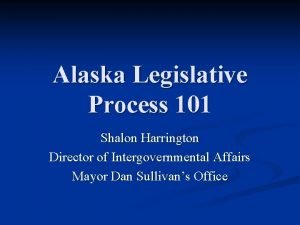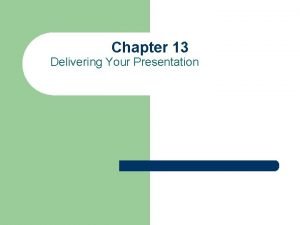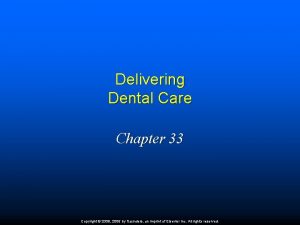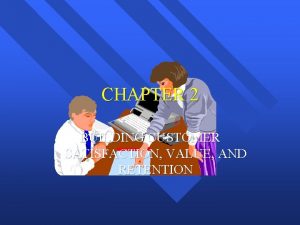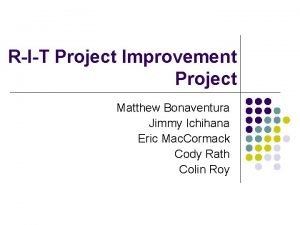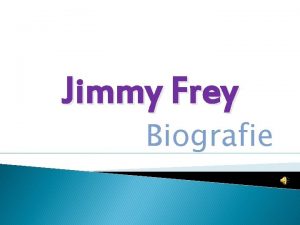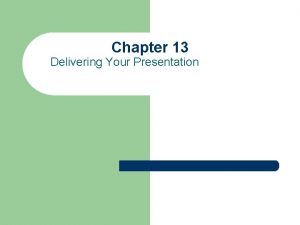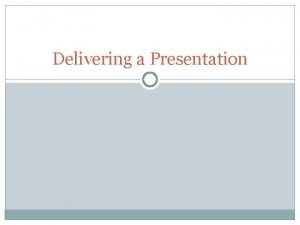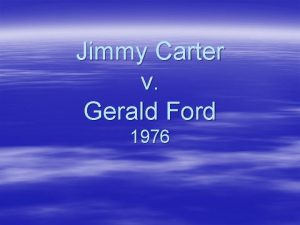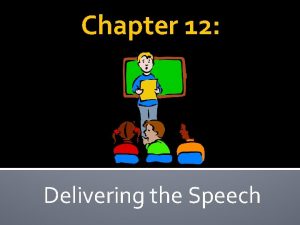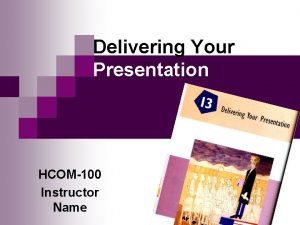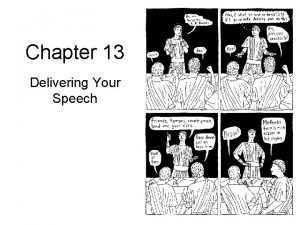DELIVERING THE PRESENTATION Chapter 12 Shalon Jimmy and


























- Slides: 26

DELIVERING THE PRESENTATION Chapter 12 Shalon, Jimmy, and Anne

OBJECTIVES Choose and use the delivery type best suited for a given presentation. Create and deliver effective extemporaneous and impromptu presentations. Conduct an effective question-and-answer session following suggested guidelines. Apply knowledge about speaker anxiety to speak effectively to others with minimal negative effects. Pg. 376

“You become the message, people cannot distinguish between the words and who speaks them. ”-Roger Ailes Pg. 377

DELIVERING A PRESENTATION The presentation has to be well delivered in order to succeed. If you look sloppy, speak in a way that is hard to understand, seem unenthusiastic, listeners doubt or reject your ideas. Pg. 377

TYPES OF PRESENTATIONS Manuscript Presentations-Speakers read their remarks word for word from a prepared statement. o Examples: Press conferences, annual company wide meetings, conventions, legal, and legislative testimony o People who don’t speak often cover nervousness with reading from a script- Comes off as a drone and unbelievable. o People are not usually trained to read out loud. = halts and jerks Pg. 378

TYPES OF PRESENTATIONS One Simple rule for presentations: DON’T READ YOUR PRESENTATION! DON’T READ PAGE 5 TWICE! Pg. 378

TYPES OF PRESENTATIONS Memorized Presentations- recited word for word from memory o Neg: Your presentation sounds memorized. • Memorizing almost always promotes stage fright. • When the presentation is memorized you focus on remembering what comes next instead of the meaning or message behind the information being delivered. o Pos: Referring to notes at a critical time can diminishes credibility. Pg. 378

TYPES OF PRESENTATIONS Extemporaneous Presentations- Planned and rehearsed, but not word for word. o Virtually every presentation should be delivered extemporaneously. • A good extemporaneous presentation is carefully rehearsed, but will never be the same twice because you speak with the audience, not at them. o Notes should be brief- overly detailed notes tempt the speaker to read them o Notes should be legible- words shouldn’t turn into meaningless scribbles o Notes should be unobtrusive- don’t let the notes be a distraction. Pg. 379

Example of Extemporaneous Presentations: Sales presentations, a talk at a local high school, progress report, training lecture, or an annual report “I tell presenters to strive for dialogue behavior in a monologue setting. Dialogue behavior is two people talking across a kitchen table. It is comfortable and natural and don’t have to think much about it. ” Pg. 379

TYPES OF PRESENTATIONS Impromptu Presentations- unexpected, off the cuff talk Guidelines for Impromptu Presentations: o Anticipate when you may be asked to speak • Always be prepared, especially if you’re an expert, or your boss has a habit of putting you on the spot. o Focus on your audience and the situation • What is on the listeners mind? • What is the attitude? • What is the circumstance in which you are speaking? o Accept the invitation with assurance • Impromptu presentations shouldn’t be taken as a threat. Look confident, if you stammer, stall or look unhappy = doubt in validity • Because you have to do it, Do it well. Pg. 380

TYPES OF PRESENTATIONS o Organize your thoughts • If time allows make an outline • Intro-thesis-body-end o Present reasons, logic, or facts to support your viewpoint • Stats • Examples • Comparisons o Don’t Apologize- no one expects impromptu presentations to be polished • Don’t highlight lack of knowledge or preparation • If you cant contribute, say so o Don’t Ramble Pg. 380

TYPES OF DELIVERY Monologue-one way speeches, delivered without interruption o Pos: more appropriate for large groups and formal settings o Neg: small groups feel artificial and creates the impression that the speaker doesn’t care Guided Discussions-more interactive. Listeners are more encouraged to ask questions o Pos: People are more willing to buy in o Neg: Harder to control, more interaction Interactive Presentations- involves more audience interaction o Neg: feels more like a conversation then a speech • Sales Pg. 377

GUIDELINES FOR DELIVERY Visual Elements o Dress effectively • What is the situation in which you are speaking • Don’t over dress or underdress o Step up to speak with confidence and authority • Don’t send nonverbal messages • Your presentation starts once you come into view of the audience o Get set before speaking • Do all your set up before you begin • “power pause” o Begin without looking at your notes • You cannot create a connection if you are reading your notes o Establish and maintain eye contact • Randomly spot around the room. Mechanical right to left makes you a robot. Maintain eye contact with each individual for a few seconds. Pg. 381

GUIDELINES FOR DELIVERY o Stand move effectively • Best stance for delivering an effective presentation is relaxed but firm. • If sitting, sit up straight and lean forward. o Don’t Pick up early o Pause, then move out confidently o A raised pitch sounds questioning Pg. 381

COMMON INTERPRUTATIONS OF A SPEAKERS BODY LANGUAGE Viewed as Arrogant Viewed as Insecure or Nervous Viewed as Open and Confident Crossed Arms Gripping the Lectern Open Hands Pounding Fists Chewing on Objects Expansive Gestures Hands on Hips Constant Throat Clearing Stepping out From Behind Podium Pointing Index Finger Playing with Objects Walking Toward or Into the Audience Hands Behind Back Rocking Back and Forth Animated Facial Expression Hands in “Steeple” Position Clenched Fists Dramatic Pauses Hands on Hem on Jacket Slouching Confident and Consistent Eye Contact


VISUAL ELEMENTS Standing Be perceived as taking charge Breathe and project Seen and be seen-maintain eye contact Stand out from other speakers Sitting Building rapport with group Considered part of the team Avoid being labeled as arrogant or show-stealing Pg. 383

VERBAL COMMUNICATION Verbal Communication-Use an oral speak style o Keep most sentences short o Use personal pronouns freely • Make the presentation more personal o Use active voice • Act as though it is presently happening o Use contractions often o Address your listeners by name o Don’t emphasize mistakes • The difference between professionals and amateurs is the way they handle mistakes o Use proper vocabulary, enunciating, and pronunciation Pg. 384 -387

Advice Poor Better Use personal pronouns freely “People often ask…” “You might ask…” Use the active voice. “It was decided that…” “We decided. ” Use contractions often. “We do not expect “We don’t expect many changes. ”

VOCAL ELEMENTS Vocal Elements o Speaking with Enthusiasm and Sincerity • If you don’t feel strongly your audience will not as well o Speak loudly enough to be heard o Avoid Disfluencies • Distfluencies- stammers and stutters such as eh, um and other filler words, like, so, okay, ya know o Vary your speech o Use pauses effectively- don’t be afraid of silence • Can be used to emphasize a point or question Pg. 387 -388

QUESTION AND ANSWER SESSIONS Question and answer sessions can be one of the biggest advantages of an oral presentation, especially if used well. When to Q & A After Presentation During the Presentation • • Immediate response Clarify any objections or confusion Usually have to allow for extra time Promise to answer premature questions later Pos: • No distractions • Control over delivery • Control over length of speech Neg: • Audience could be distracted over questions and miss the meaning of the presentation Pg. 389 -392

HOW TO HANDLE QUESTIONS Start the ball rolling Anticipating likely Questions Clarify complicated or confusing questions Treat questioners with respect Keep answers focused on your goal Buy time when necessary Address answers to the entire audience Follow the last question with a summary

USING VIDEO TO ANALYSE YOUR PRESENTATION Record your rehearsals to see how the audience perceives you. This tool helps you to see things that you don’t like so you can work on them before presenting As is Muted: look for physical presence, posture, gesture, facial expression Audio Only: listen to see if you are easily understood, fluent, enthusiastic Fast Forward- See important expressions, movements, mannerisms become apparent. Pg. 386

MINIMIZING AUDIENCE INTERUPTIONS Post a sign outside the room warning that a presentation is in progress o Close doors before speaking Program telephones in the room to ring elsewhere o Ask people to please silence their phones Ask that questions and comments be held until the end of the presentation Check with service personal or post notices outside the room to sure refreshments aren’t delivered in the middle of your presentation Be certain that setup for another event isn’t about to begin in your room before you are finished

CONFIDENCE-BUILDING STRATEGIES Before, walk around and stretch to relieve stress o Avoid alcohol and caffeine Rehearse in front of friends and family to receive honest feedback Walk around the room and talk with listeners before presentation- helps to familiarize yourself with the audience Remember: Presentations aren’t brain surgery! You are sharing what you know to people who want to know it Wear clothing that is familiar- new outfits can add to discomfort During presentation seek out familiar faces and maintain eye contact Don’t try to be anyone else. Develop your own approach. Pg. 393

SPEAKING WITH CONFIDENCE Accept a Moderate Amount of Nervousness Speak more often Rehearse your presentation o Rehearse on your feet, before an audience o Expect your talk to run 20 percent longer o Pay special attention to your introduction and conclusion o Rehearse in a real setting Focus on Your topic and Audience, Not yourself Think Rationally About Your Presentation o Myth: Presentation Must Be Perfect o Myth: It is possible to Persuade the Entire Audience o Myth: The Worst Will Probably Happen Pg. 393
 Shalon harrington
Shalon harrington Designing and delivering oral and online presentations
Designing and delivering oral and online presentations Delivering your presentation
Delivering your presentation Sarah is delivering a presentation on the solar system
Sarah is delivering a presentation on the solar system Delivering dental care chapter 33
Delivering dental care chapter 33 Marketing channels: delivering customer value
Marketing channels: delivering customer value Building customer satisfaction value and retention
Building customer satisfaction value and retention Genevieve was obsessed with details
Genevieve was obsessed with details Jimmy & joanne moriarty
Jimmy & joanne moriarty Manuscript for speech
Manuscript for speech Outline of entertainment speech
Outline of entertainment speech Rvp factory
Rvp factory Jimmy ichihana
Jimmy ichihana Jimmy huang nottingham
Jimmy huang nottingham Canciones belgas más famosas
Canciones belgas más famosas Jimmy carter
Jimmy carter Gadsden purchase jimmy fallon
Gadsden purchase jimmy fallon Jimmy frey ziekte
Jimmy frey ziekte Retailmenot jimmy johns
Retailmenot jimmy johns Jimmy cosmo cournoyer
Jimmy cosmo cournoyer Jimmy irwin
Jimmy irwin Jimmy akintonde
Jimmy akintonde Lead singer of jimmy eat world
Lead singer of jimmy eat world Jimmy kennedy istanbul
Jimmy kennedy istanbul Jimmy goh giam hwee
Jimmy goh giam hwee Pillsbury frozen biscuits sam's club
Pillsbury frozen biscuits sam's club Jimmy burleson
Jimmy burleson
